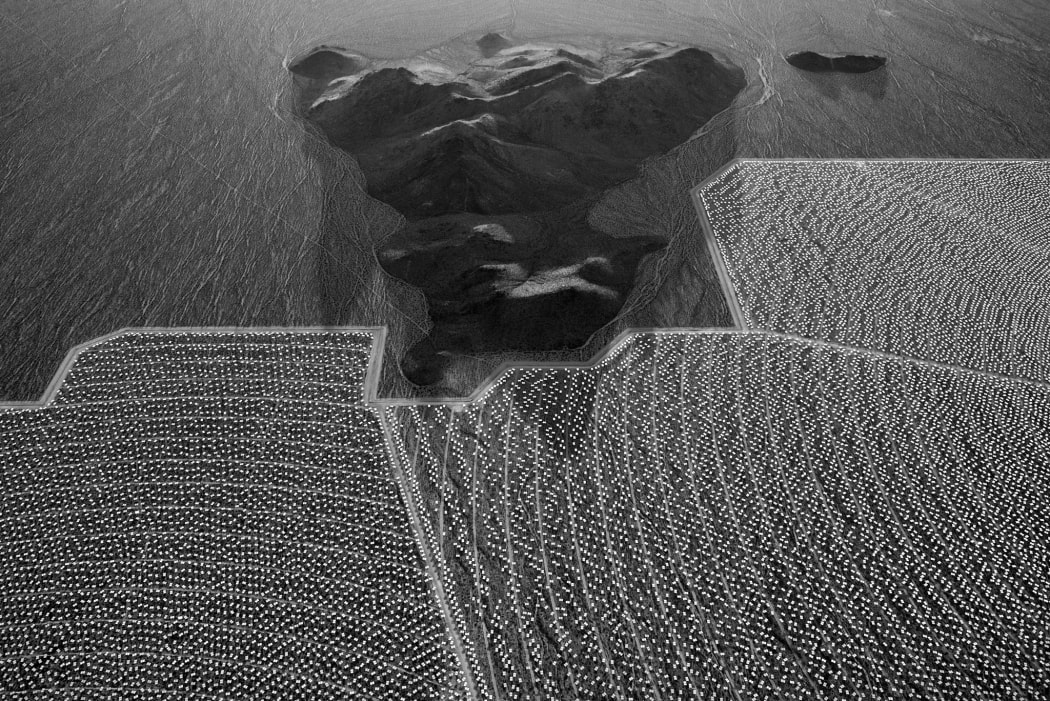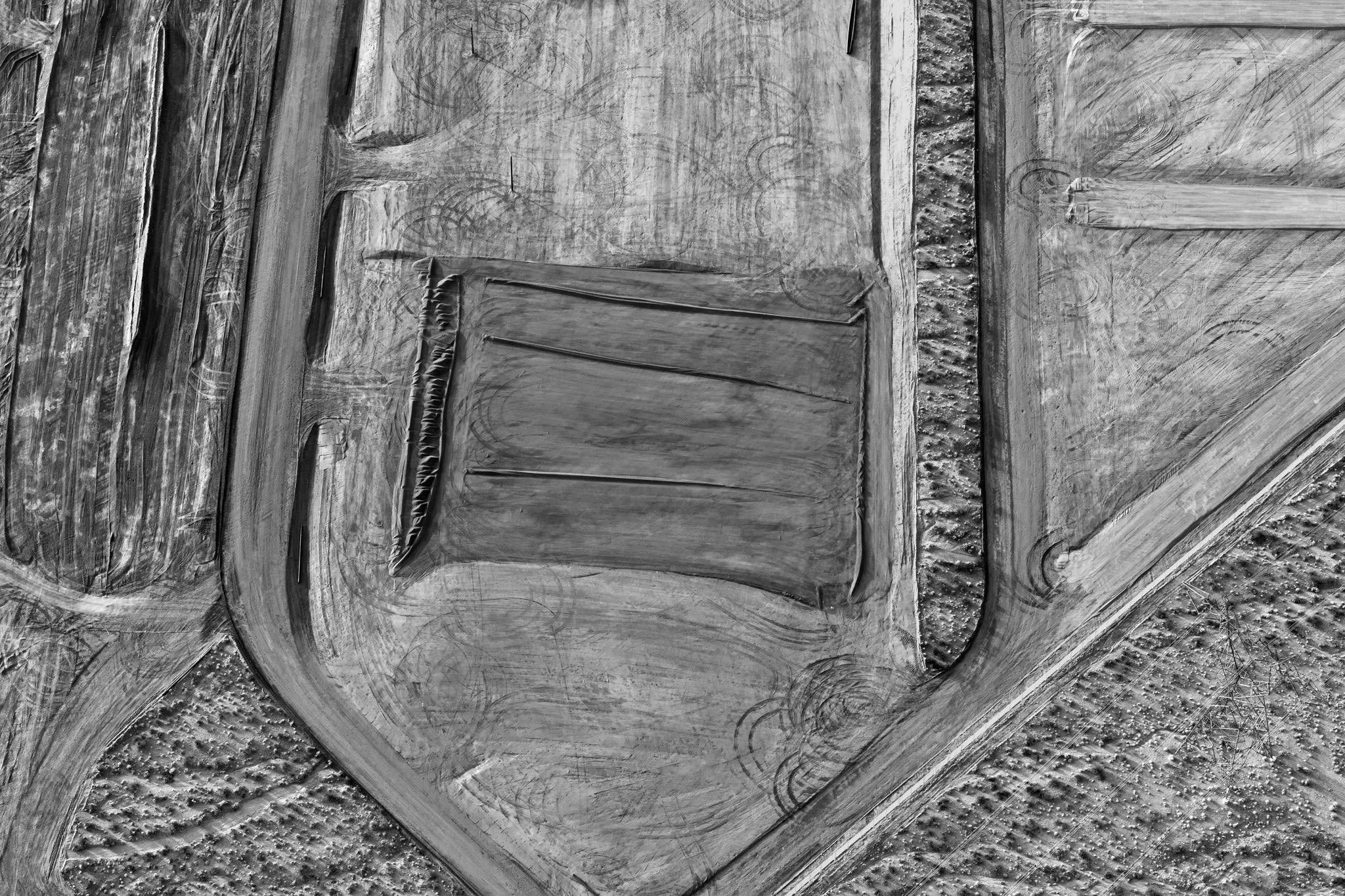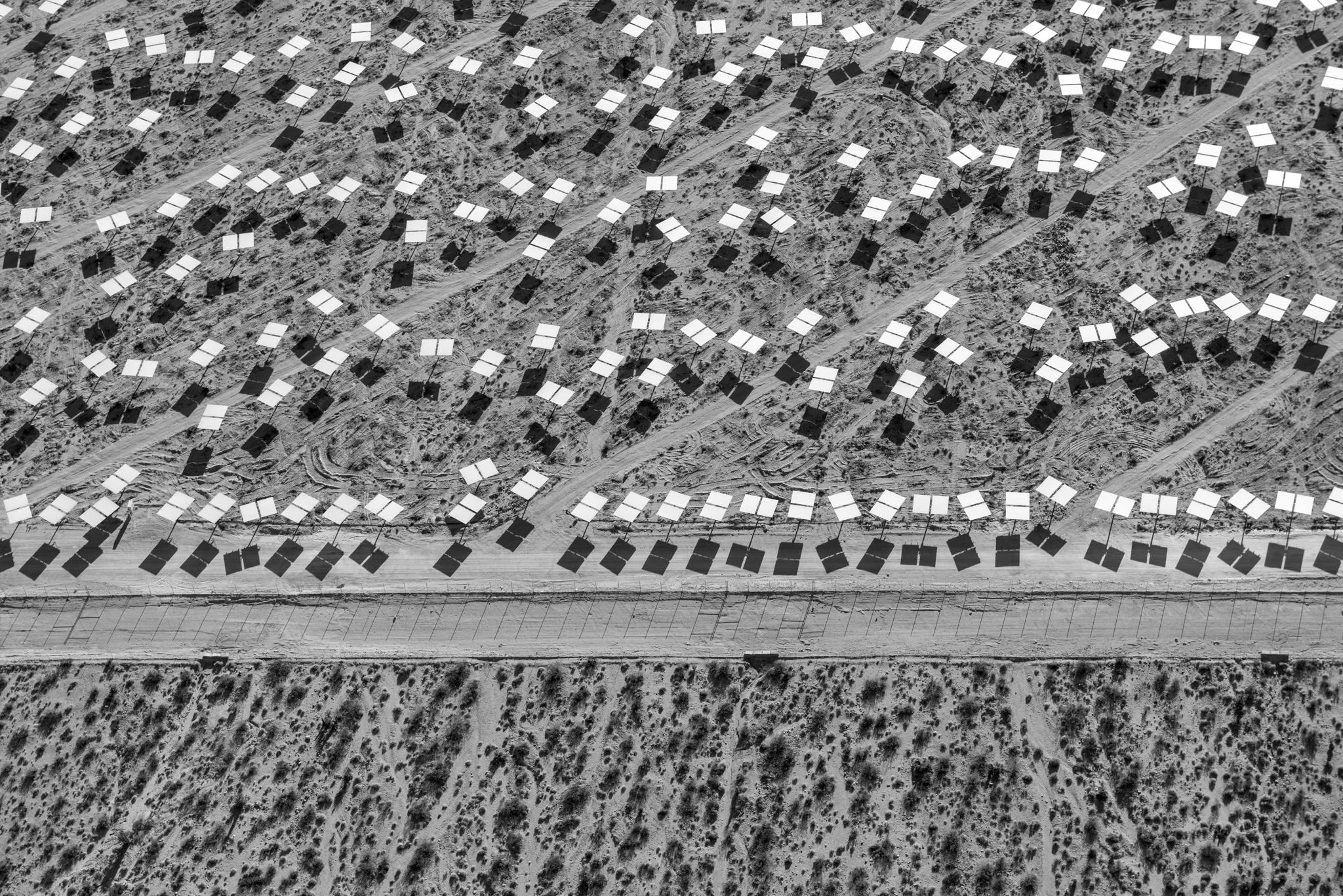
Aerial photography gives the art of the landscape image a very different perspective. Cameras were taken into the air in the earliest days of photography. “The first to successfully accomplish this feat was Gaspar Felix Tournachon or “Nadar” in 1858 when he photographed the houses of the French village of Petit-Becetre from a balloon tethered at a height of 80 meters”. (1) One can now see amazing satellite images of the earth from miles up that are available from NASA, the US Geological Survey or more readily, Google Earth. (2) “…[O]ur generation is becoming accustomed to Google Earth and the neighborhood surveillance imagery over the world wide web”. (3) With the broadening and increasing common use of drones, almost anyone can take an aerial image. (4) So how and why can we better appreciate an image taken by a professional art photographer?
The appreciation of an aerial photographic image as art is challenged by the spreading and easy access to photographic images from above. (5) Appreciating aerial images as an interesting object, as art (6) and/or items of documentary importance requires a new framework. (7) Rebecca Senf, Curator of Photography at the Center for Creative Photography has said that: “Despite some similarities among aerial photographs, photographers have worked in different styles to engage the medium to achieve different ends.” (8) In watching a lecture by William Fox, Director for the the Center of Art & Environment at the Nevada Museum of Art, he seemed to suggest that with an aerial photograph we look and study the image because we want to find out where we are in relation to the image, driven by an internal desire to better understand our macro environment. (9) In this Commentary, I explore this genre through the eyes of a photographic artist using aerial photography to help create such a framework. (10)
Four images were selected from Jamey Stillings’ Ivanpah Solar (11) series to explore his capture, over time, of a man-made change on the the earth’s surface. Jamey Stillings’ work is photography with a purpose, and many of his images, from my perspective, are artistically very interesting. (12) In speaking with Stillings, he expressed that: “People don’t have a visual framework for energy projects in the landscape”. He commented further that he wants people to have a sense and feeling of these projects and to think more critically about this and similar energy projects. His Ivanpah project combines an environmentalist’s sensitivity with images that challenges us visually. As a photographer he is focusing attention on the intersection of nature and human activity and capturing how humans are transforming the earth. (13) “As an artist, aerial photography is a principal component of my work. I explore perspectives distinct from those found on earth’s surface, revealing information and insight otherwise concealed.”
He chose to study (14) and photograph the Ivanpah Solar power plant in the Mohave Desert because, according to Stillings, it would become the world’s largest concentrated solar power plant, will reduce carbon emissions significantly, and provide a sustainable source of electricity. (15)
Its important to put Stillings use of this photographic approach in perspective. In 2007, Kim Sichel at Boston University curated the exhibition “To Fly: Contemporary Aerial Photography”. (16) The exhibition captured an important distinction in looking at landscape photography: a view from above compared to traditional “feet on the ground” landscape work. Sichel commented that “aerial imagery often offers no one-point perspective, no horizon, no vanishing point, no nuance of light and shadow and no sky. Additionally, she notes, the world in this imagery is unpopulated because the scale is too vast to allow human figuration. Thus, “aerial photographs present a world that is shaped by man but not visibly inhabited by humans”.” (17) While her observation is a broad and general statement, it does capture, for me, a very important difference in appreciating an aerial landscape from the broader population of landscape imagery by other photographers, artists or scientists. Rebecca Senf (18) also captured a similar sense of aerial photographic work in her 2013 exhibition, at the Center for Creative Photography, “From Above: Aerial Photography”. In this exhibition she captured some of the different uses for aerial photography. (19)
When I look at Stillings’ image #897, 14 January 2011 from the Evolution of Ivanpah Solar, I see an abstract assembly of shapes that remind me of the “peeling paint” abstract photographic work of Aaron Siskind. (20) Initially, I am not sure what it is that I am seeing when I study this image, but I have a very favorable visceral reaction. I am left with the question, what is it, or what is it going to be? Then I realize that it is a landscape and, as clarified by Stillings, the “natural erosion gullies of alluvial slope overlap with boundary and service roads of unit 2”. Stillings stated his intent is to move the viewer from a “Narrative” (“what is it?”) examination of the image to something “Metaphoric” (21) and “Transformative”.

In #5490, 6 January 2012, Stillings shows us an image that looks like a river reaching into a gulf; but with encroachment from the right of very controlled lines and waves. We know the hand of man has touched the earth and scratched into it something, but we don’t know yet what that something is. (22) From this perspective, understanding of form is misleading. We can’t perceive height or depth, or structure or material. We can just see that something is there and that something has happened. It is that mystery that engages us in many aerial photographs. But instead of a general view from above of what we know is a place on the earth, we know also something has happened in this place.

Stillings is not the only photographer to have a purpose in taking to the sky to document man’s impact on earth. (23) As an intense forward-looking study (24) following the development of a specific project, Stillings creates a dialogue with an understanding of the business behind that activity. Another aerial photographer, David Maisel, also uses aerial photography to expose environmentally affected parts of the earth’s surface, making dramatic images of the distressed terrain. (25) Maisel explores hard issues such as open pit mining, the use and depletion of the Owens Lake project or the destruction of the forests following the explosion of Mount Saint Helens. What is captivating about this type of photography, that for me also can apply to Stillings’ work, was expressed by Julian Cox, Curator of Photography for the Fine Arts Museum of San Francisco when speaking about Maisel’s work, he suggested that the viewer doesn’t necessarily understand what you see initially… but are left with questions. (26)
We begin to see the development of this solar power project in the next two images. Image #10006, 25 June 2013, transitions us to an answer for the question – “what is it?”. We now see structures beautifully patterned by shadows from a sun no doubt rising or setting on the horizon. (27) Stillings is very conscious of light and shadow. He has very clearly captured the sun’s impression on objects which he uses to better define what we see. (28) There is a tension in that the structures are both bringing organization to the image, or order, but their seemingly random pattern appears to work against that sense of order. We expect when something is built that it is solid and rigid. But these mirrors (or ‘heliostats’, as they are called in the industry) meander across the landscape giving a casualness to the image. Despite their formal, planned and industrial purpose to produce electricity for use by people or industry miles away, our guard is taken down somewhat by the informality of the pattern. The lower third of the picture is untouched land, clearly contrasted against structures pounded into the earth on the upper two-thirds of the image. The lack of a horizon line allows the image to be more artistic than documentary, even though it is documentary. A story is also clearly coming forward. He displays a talent as a storyteller in his sequencing of images, and the completeness by which he traces the development of this project over time. This distinguishes Stillings’ images as more than just technically well executed and enjoyable photography. There is story-telling and a dialogue in which the photographer is asking us to participate. (29)

Capturing a story is also more difficult with aerial photography than one might initially think. We relate to people in telling a story. However, the ability to see people in these images from these heights is difficult, but structures that people build can be brought into view, directly or in abstraction. In some of the later images in the Ivanpah series, there are images of people in and around the heliostats. But, from the air there is a different dialogue put forward with remarkable visual consistency. The images are tied together not just by the subject, but visually in how well the eye can adjust from one image to the next. It is clearly demonstrated in these four images. To paraphrase Richard Woldendorp, a Dutch-born Australian photographer, consider that it is hard to ever take the same photo twice because the airplane is constantly moving, with differing elevations, changes in light and haze, climate changes, positions of the airplane and flight path. 30 In Stillings’ images, the visual consistency he has achieved between images has to be respected and appreciated.
With image #9499, 21 March 2013, from The Evolution of Ivanpah Solar, we see a literal line drawn between man and nature. While hard to tell size or elevation, a “rock”, or more likely a mountain, sits immoveable before an encroaching wave, or flood, of more heliostats than we can count. (31) Just like a barrier of rocks in a stream, the heliostats seem positioned to flow freely around this barrier. This confrontation of man-made objects and nature in his images is the art, the documentation, the story and the dialogue. It is all of the photographs in the series, brought together in a visual crescendo. Planned. Intended. Visually challenging.

Images used with permission of Jamey Stillings.
Notes:
- See the “History of Aerial Photography” website http://www.aerialarts.com/History/history.htm
- See a recent Feature Shoot Internet Magazine article, Ellyn Kail, “45 ASTONISHING, ABSTRACT AERIAL IMAGES FOUND ON GOOGLE EARTH“ issued on August 19, 2015 http://www.featureshoot.com/2015/08/45-astonishing-abstract-aerial-images-found-on-google-earth/ . See the NASA site also at http://earthobservatory.nasa.gov/Features/OrbitsCatalog/ And, the US Geological Survey Site at http://pubs.usgs.gov/gip/AerialPhotos_SatImages/aerial.html
- Assistant Professor Kim Sichel, Boston University speaking about her 2007 aerial photography exhibition “To Fly”. http://www.bu.edu/cfa/the-boston-university-art-gallery-presents-to-fly-contemporary-aerial-photography/
- “I think that photography, or what we currently consider photography, will become more about the concept or the idea driving the picture than the actual picture itself. Maybe that has always been the case. Metaphors are obviously applicable to everything, and you can find them in everything, if you want to. It’s not so much the picture—or, it’s not so much the information in the picture—it’s the spin on it. Information does not equal meaning. Meaning is bigger than information.” Michael Light, an aerial photographer focused on the environment and how contemporary American culture relates to it, in an interview in 2013 “Spacial Delirium:An Interview with Michael Light” with Geoff Manaugh and Nicola Twilley. in BLDGBLOG.
- One reaction might be found in this statement from “After Photography” by Fred Ritchin, page 126, 2009, W.W.Norton & Company: “For children, young people, and others photographing their own environments, their imagery is usually not as stylized and self-censored as that of professionals, particularly because there is little attempt to imitate a “good” photograph, in part because they have limited experience of the photographic literature.”
- Collector Daily web magazine, July 15, 2009, in a commentary on Loring Knoblauch’s book “William Garnett, Aerial Photographs” commented: “While Aerial photography began back with balloon flights and early airplane experiments decades earlier, William Garnett was the first flying photographer to move images beyond their geographical/topographical/military beginnings and into the realm of art”.
- There is a broad group of contemporary photographers who have used aerial photography in their bodies of work. In the interview with Jamey Stillings, some of the photographers taking aerial photos we discussed and considered in the context of this commentary included: William Garnett, Emmet Gowin, Terry Evans, Yann Arthus-Bertrand, Alex MacLean, Marilyn Bridges, Edward Burtynsky, Michael Light, Adriel Heisey, George Steinmetz, David Maisel, Garth Lenz, Daniel Beltra, and Kasper (Kacper) Kowalski.
- Rebecca Senf, Norton Family Curator of Photography, Center for Creative Photography and the Phoenix Museum of Art. From her introduction to the 2013 exhibition: “From Above: Aerial Photography from the Center for Creative Photography”.
- “Aereality” on YouTube, 10/1/2013, StudioXNYC video of the Lecture by William Fox, the Director of the Center for Art & Environment at the Nevada Museum of Art.
- A different landscape framework was created in one of my prior “Commentaries”, published July 15, 2015, on appreciating the Plains landscape by examining the work of photographer and educator Peter T. Brown.
- See http://www.jameystillingsprojects.com From material provided by Jamey Stillings, he commented: “Ivanpah Solar, in the Mojave Desert of California, …became the world’s largest concentrated solar power plant. 173,500 heliostats (347,000 mirrors) now focus the sun’s energy toward three towers with the capacity to create 392 megawatts of electricity, enough for 140,000 US homes.”
- It is interesting to note that Jamey Stillings originally also wanted to have access on the ground to the project, but was unable to get it. He feels that this limitation on access actually caused his work to become a “stronger and deeper statement”.
- “Changing Perspectives-The promise and Challenge of Renewable Energy”, Jamey Stillings, TEDx Talk, YouTube, October 28, 2014.
- “… While Ivanpah Solar is located in the American West, the issues that have surfaced during its planning and construction are global ones and relevant to any environmentally responsible large-scale project. …. In 2010, I initiated CHANGING PERSPECTIVES: The Evolution of Ivanpah Solar, an aerial photographic survey that continued through Ivanpah Solar’s completion. The finished project will become both a traveling exhibition and a large-format book published by Steidl in autumn 2015. CHANGING PERSPECTIVES is now the name for a connected set of projects on which I will be working over the next several years. Building on the work at Ivanpah Solar, CHANGING PERSPECTIVES: Energy in the American West, will expand my examination of utility-scale renewable energy projects while selectively documenting domestic fossil fuel extraction, exportation, and energy production.” Extracted from Information provided by Jamey Stillings on his project and images.
- From “Changing Perspectives-The promise and Challenge of Renewable Energy”, Jamey Stillings, TEDx Talk, YouTube, October 28, 2014.
- Exhibited September 5, 2007. Kim Sichel at that time was an an Associate Professor of the History of Photography and Modern Art at Boston University. The exhibition featured 50 images by 13 artists. Among those 13 photographers, which will be further referenced in this “commentary” were: Alex S. MacLean, Adriel Heisey and David Maisel.
- http://www.bu.edu/cfa/the-boston-university-art-gallery-presents-to-fly-contemporary-aerial-photography/
- It is interesting to know that Kim Sichel was Rebecca Senf’s academic advisor while at Boston University.
- The brochure for the exhibition highlights: Military reconnaissance and peacetime survey (Edward Steichen and Captain Albert W. Stevens); Scientific Exploration (Bradford Washburn); Photojournalism (W. Eugene Smith); Aerial Photography as Art (WIlliam Garnett and Marilyn Bridges).
- A short video interview with Aaron Siskind and some of his abstract images: http://lumieregallery.net/wp/202/aaron-siskind/
- Metaphoric (adjective) – a word or phrase (or in this case an image) ordinarily and primarily used of one thing is applied to another. Webster’s New World Dictionary (2004, 4th Edition).
- It is actually a “detail of the initial excavation and ground preparation near existing grid transmission lines”.
- For example, see http://danielbeltra.photoshelter.com/#!/index
- The partnership of Dr. Patricia MacDonald and her husband Professor Angus MacDonald also use aerial photography for their studies. The Aerographica Partnership “specializes in environmental research, record and interpretation of the history and present condition of the natural heritage (including the earth heritage) and of cultural landscapes…”. See http://aerographica.org/about/
- David Maisel’s series of work can be founds at http://davidmaisel.com.
- Comment by Julian Cox heard in the YouTube presentation “The Bleak Beauty of Daniel Maisel’s Aerial Photographs”; KQED Arts. July 7, 2015.
- “Heliostats near the boundary of Unit 3.” Capturing this image at the right time of day is an important compositional decision, that again may separate one image and photographer from another in an effort to conceptualize what they want, and to make the sacrifice to be in the right place at the right time.
- Michael Light, an aerial photographer focused on the environment and how contemporary American culture relates to it, said in an interview about his own work: “… the landscape is so perceptually dependent on the type of light that’s illuminating it. You really do get radically different spaces in different kinds of light. A different kind of vibe. Seasons will also change the way a landscape looks—or, I should say, the light itself seasonally changes.” The interview was in 2013 “Spacial Delirium:An Interview with Michael Light” by Geoff Manaugh and Nicola Twilley. in BLDGBLOG.
- Watch New Mexico PBS on YouTube “Colores!: Jamey Stillings”, KNME-TV. Stillings comments about “human imposed geometry on a more organic landscape.. the human element was quite managed…precise…so the mixing of organic become interesting…”.
- Richard Woldendorp talking about “Abstract Earth”, a four part video from the Art Gallery of Western Australia’s “Talk with the Artist” series. https://www.youtube.com/watch?v=ezxELi3L0Pg and http://www.artgallery.wa.gov.au/exhibitions/Richard_Woldendorp_Abstract_Earth.asp
- According to Stillings’ notes: “A hill formation rises above the alluvial slope at the eastern boundaries of Units 2 and 3 with heliostat installation complete.”